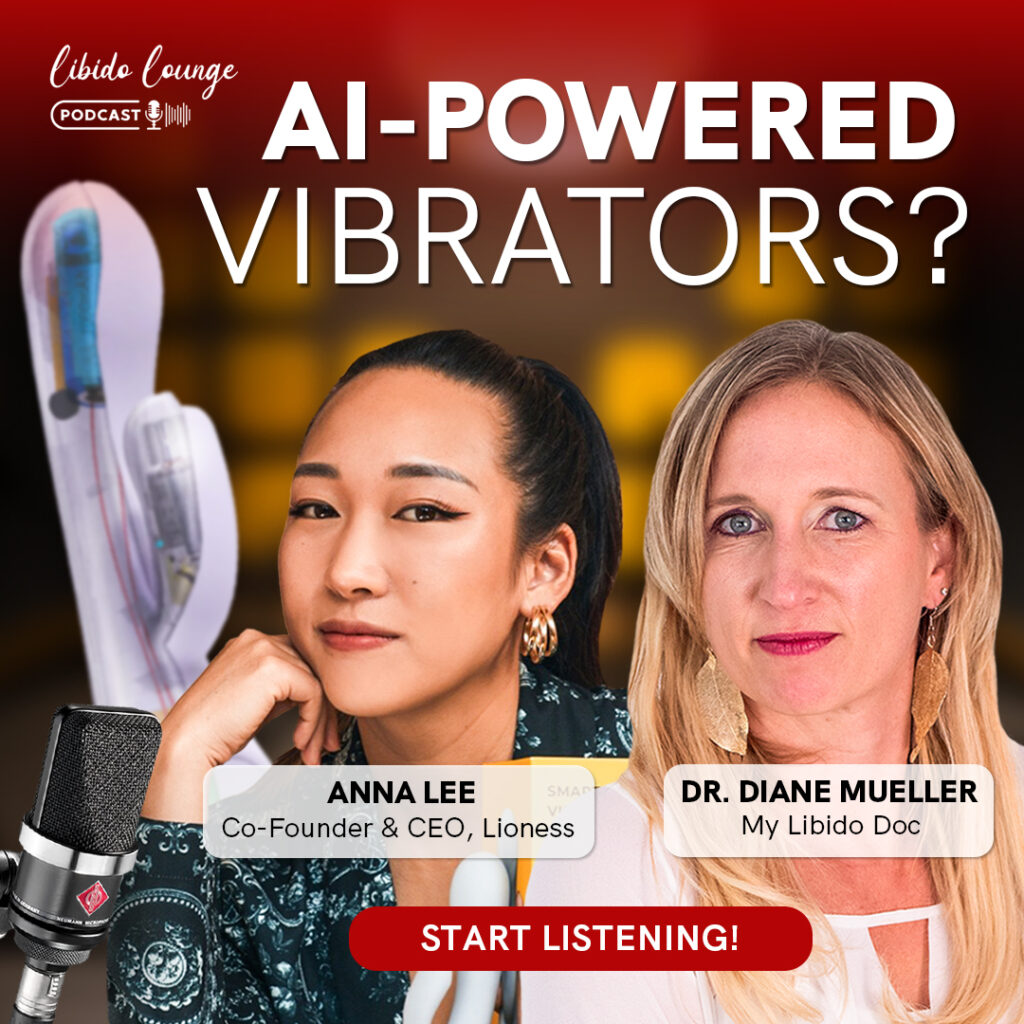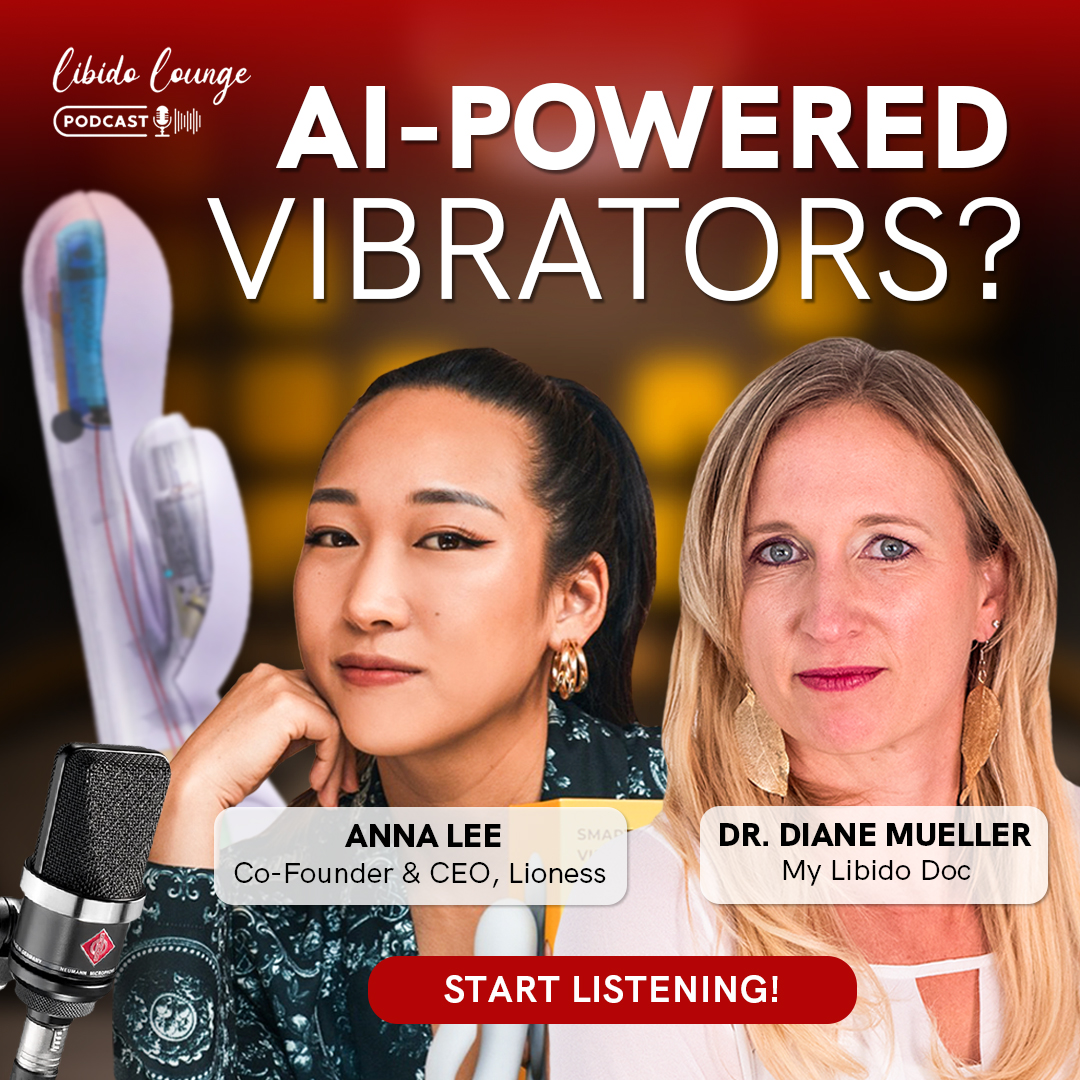Is This the Future of Sex? Exploring AI-Driven Pleasure Devices | Ep 61
Episode 61

Have you ever wondered what your orgasm patterns can reveal about you?
In this episode of The Libido Lounge, Dr. Diane dives into a fascinating conversation with Anna Lee, co-founder of Lioness—the world’s first smart vibrator that gives you biofeedback about your own pleasure. Anna shares how the device not only tracks your orgasms but helps you understand what factors like stress, caffeine, or even time of day do to your pleasure.
Listen in as Anna explains how Lioness went from an idea to a revolutionary tool for sexual wellness. Discover the three unique orgasm patterns—ocean wave, avalanche, and volcano—and find out why understanding your data can transform both solo and partnered pleasure. Whether you’re curious about leveling up your sex life or want to learn more about your body, this episode offers a deep dive into how data can empower your sexuality. ✨
Plus, enjoy a special 10% discount.
📌Link: www.lioness.io.
📌Code: LIBIDOLOUNGE.
Get ready to embrace a data-driven approach to pleasure!
Key Topics Explored:
- Discover how the Lioness vibrator works and its unique features.
- Understand the benefits of biofeedback data for enhancing sexual pleasure.
- Learn about the different orgasm patterns identified from user data.
- Explore the impact of stress and other factors on sexual pleasure.
- Find out how the Lioness vibrator can improve partner communication and foreplay.
About the Guest:
Anna Lee is the co-founder and CEO of Lioness, a pioneering startup behind the world’s first smart vibrator, designed to track and analyze orgasm data through science. Before founding Lioness, Anna worked as a mechanical engineer at Amazon, where she helped develop the original concept for the Amazon Dash Button and the Kindle Voyage Page Press Technology. Recognized for her impactful work, she was named one of Newsweek’s 10 Innovators Disrupting Healthcare and featured in Forbes’ 30 Under 30. Anna is dedicated to advancing research and awareness in sexual pleasure.
Take Our Libido Quiz! https://t.ly/quoNU
Table of Contents
Welcome to the Libido Lounge
Dr. Diane: Welcome to the Libido Lounge, where we focus on all things love, lust, and libido. We believe that fabulous sex is as important to health as exercise and good food. Hey everybody, welcome back to another episode! I’m your host, Dr. Diane, your libido expert, and I have a juicy episode in store for you today. Joining me is Anna Lee, one of the founders of the Lioness vibrator—and let me tell you, this is not your usual vibrator.
Before we dive into the details of today’s conversation, I want to remind you that research and my own clinical experience show vibrator use can help with pain during sex, numbness, pelvic floor dysfunction, better and longer orgasms, vaginal dryness, connection with a partner, and so much more. Vibrators aren’t just for pleasure—they can be healing tools too.
Today we’re talking about a very special vibrator. We’ll explore what makes it unique, what inspired Anna to create it, and how it’s changing the way people engage with their pleasure.
What Makes the Lioness Vibrator Different?
Dr. Diane: Welcome, Anna, and thank you for being here!
Anna: Thanks for having me! That was such a lovely introduction.
Dr. Diane: Your product is amazing. Before we get into all the juicy fun, let’s set the stage. I’ll share my experience, and I’d love to hear yours too. Can you tell us what makes the Lioness different from the standard vibrator?
Anna: It may look like a typical rabbit-style vibrator, but it’s the first and only smart vibrator that gives you biofeedback data about your own pleasure and orgasms. We like to say it’s like a Fitbit or Oura Ring for your sexual pleasure. It helps you understand what’s working, what’s changing, and what your body is telling you—something most people never track.
Dr. Diane: That’s exactly what I’ve found, too. I’ve been a fan of vibrators for decades, and I’ve been using the Lioness for about three or four weeks now. What I’ve noticed right away is that, just like with a Fitbit, when you get that feedback, it creates this dopamine loop—motivation to explore more. It’s actually increased the time I spend in pleasure, both with myself and my partner. The data makes me more curious, and that curiosity deepens my self-care and pleasure practices.
Anna: I completely relate. Before starting this company, I was really scared of my own body. I’d maybe masturbate but never think about what made it a good experience. With the data from Lioness, I slowly started to understand my body from a physiological perspective. That helped me embrace my sexuality and feel more comfortable in my skin. You really nailed it—knowledge is pleasure.
Using the Lioness for Partnered Play
Dr. Diane: I’m curious about what you’ve seen in partner play. Sometimes vibrators can be intimidating in relationships, especially for the partner. But I think this product, with its feedback component, might actually make it easier to bring partners in and get creative together.
Anna: Absolutely. A lot of people think of vibrators as solo tools. But during research and testing, we found people sharing their data with their partners—like, “Look what this session looked like!” One tester told us she had a hard time bringing up that she wanted more foreplay. So she brought in the toy and used it as a fun way to show, “Hey, it took me 30 minutes to get to orgasm with just the vibrator.” Her partner saw the data and finally got it—he realized she needed more time and buildup. It became a playful, non-accusatory way to communicate and explore together.
Dr. Diane: That’s amazing. It becomes about curiosity and creativity, not criticism. And it’s a great way to de-stigmatize toys in relationships.
How the Lioness Came to Life
Dr. Diane: Let’s go back to the beginning—what inspired you to create the Lioness?
Anna: My background is in mechanical engineering—I used to work at Amazon building Kindles. About nine years ago, I wanted to build a better vibrator. At the time, I was very scared of my body and never thought I’d be doing interviews like this. But I saw that vibrators hadn’t really evolved in their engineering. The sex toy industry was (and still is) male-dominated. I met a guy from a now-defunct sex toy company who said he tested vibrators by putting them on his nose. That’s what he thought a clitoris feels like! That moment made me realize how little real feedback or research went into designing for vulvas.
At first, we wanted to build an AI-powered vibrator that could learn from you and adjust. But we quickly discovered how little research exists on female pleasure. The one meaningful study we found was from the 1980s, showing that orgasms involve rhythmic pelvic floor contractions. That became the basis of our technology.
Dr. Diane: It’s shocking how little data exists. No wonder scientists, professors, and pharmaceutical companies struggle with female pleasure and disorders—it’s so individual. And your vibrator helps women track their unique erotic responses, right?
Anna: Exactly. It’s not about being analytical all the time, but taking time to reflect—what’s working for me? I recently looked at my data from 2017 versus now. It takes me longer to orgasm now, but the orgasms are longer and more intense. I didn’t realize this until I compared the data. It shows how we grow and change in our sexual selves.
The Emotional Power of Pleasure Data
Dr. Diane: There’s something really healing about looking at this without judgment. Data helps take away fear, stigma, and self-doubt. It’s just feedback.
Anna: Totally. I’ve learned that stress kills my pleasure—literally. I can see it in the data. When my cortisol is high, I barely feel my orgasm, or it becomes a tiny blip. I was able to show that to partners and say, “Look, I’m not broken—it’s stress.” It helped me have those conversations from a place of understanding instead of frustration.
Dr. Diane: And I bet you get the question “Am I normal?” all the time.
Anna: Constantly. And the answer is yes. Everyone’s body is normal. It’s just about learning your unique patterns.
What the Data Shows: Orgasm Patterns
Dr. Diane: Have you seen any common orgasm patterns in the data you’re collecting?
Anna: Yes! We now have the world’s largest dataset on female sexual function. One of our proudest contributions is a study published with Dr. Jim Pfaus from Prague University. We found three main orgasm patterns:
- Ocean Wave: The most common. Rhythmic squeezes and relaxations, just like ocean waves.
- Avalanche: Starts with strong contractions that gradually weaken—like a downward slope.
- Volcano: A sudden, intense spike and drop—what you see in movies.
These patterns help people realize that different orgasms aren’t “wrong.” They’re just different.
Dr. Diane: Wow, that’s fascinating. Do you have stats on how common each one is?
Anna: It’s tough to give percentages because some people change patterns over time. Originally, we thought people stayed consistent. But now we’ve seen users shift between types—like I’m mostly ocean wave, but I’ve seen avalanche patterns recently. Still, about 80% tend to fall into the ocean wave category.
Dr. Diane: That’s incredible insight into pleasure. Thank you so much for sharing all of this with us!
Closing Thoughts
Dr. Diane: Anna, thank you for your work, your vulnerability, and your leadership in helping us all understand our bodies better. This has been such a fun and enlightening conversation.
You can find me on YouTube, on Instagram, and check out our Modern Libido Club for so much more!
–
Our advocacy is centered around providing a supportive space for women to reclaim sexual vitality and joy for good. Help us achieve this by subscribing to our podcast and sharing us with your friends and family.
💖 Join our Next Libido Masterclass (mylibidodoc.com/)
💖 Access Lab Testing: https://platinumself.circle.so/c/community
More Libido Lounge
✨ Website | mylibidodoc.com/podcasts/
✨ YouTube | youtube.com/@mylibidodoc
✨ Instagram |instagram.com/mylibidodoc/
✨ Health Store | https://store.mylibidodoc.com/










